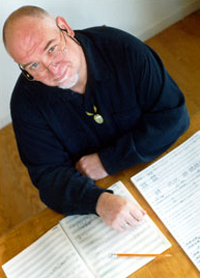by Mike Telin

The evening began with the world premiere of Roger Briggs’ Fountain of Youth. Introducing the composer, Mitchell said that Briggs had been an important teacher and mentor to him during his undergraduate years at Western Washington University. The idea to commission the work a came about when Briggs remarked in an email that someday he hoped to write a piece for one of Mitchell’s orchestras. “I thought, why wait for someday?” Mitchell told the audience. “It would be so special to have my teacher from when I was in my late teens write a piece for me to play with my 17- and 18-year-olds.”
In his remarks Roger Briggs said that the mythical fountain of youth, literal fountains, and fountains as a metaphor for the cycle of life inspired his work.
Written in a single movement, the work is scored for large ensemble — full wind, brass and percussion sections, as well as amplified piano, celesta, and harp. With a loud strike of the bass drum, Fountain of Youth is off and running at breakneck speed. Rapid technical passages in the strings give way to handsome fanfares in the brass, while the percussion section, which includes some very tricky passages for the mallet players, keep the music moving forward until it reaches a climax and a serene calmness prevails. Then, with loud snap-pizzicatos in the low strings, the race resumes until the thick musical textures gradually become transparent until the final notes fade away to nothingness.
Drawing a full, clear sound from his players, who were at the top of their game from beginning to end, Mitchell led an energetic, rhythmically secure performance of the captivating eighteen-minute tone-poem. The audience and the orchestra cheered as Roger Briggs came on stage to take a bow. It was a pleasure to be introduced to Briggs’s music and hopefully we will hear more of it in the future.
Anton Bruckner’s Symphony No. 4 (“Romantic”) is a monumental work that requires an orchestra to have a mature understanding of large ensemble playing, individual musical prowess, and — with a duration of 65 minutes — a concentration level not often required of a youth orchestra. However, Mitchell and the Orchestra proved they were more than up to the task during their impressive performance of the 1874 version of the work.
Bruckner’s Symphony also requires a principal horn player with nerves of steel, and Michael Rising sounded magnificent during the work’s haunting opening solo, as he did throughout the performance. Mitchell’s pacing of the opening “Bewegt, nicht zu schnell,” allowed the music to breathe, and never become stagnant. The strings sounded full-bodied, never tiring during the movement’s long phrases, and the winds and brass played with a warmth that was never overpowering.
Mitchell led a nuanced Andante, and the cellos and violas produced beautiful section solos. Although things were not perfectly aligned during the opening of the Scherzo, everything settled into place, and the movement finished in glorious fashion. The Orchestra unleashed a huge sound during the Finale. Here too, Mitchell’s thoughtful pacing, combined with subtle tempo changes, kept the very long movement sounding fresh and captivating. This was a spectacular performance, and the large audience showed their appreciation with an immediate and long ovation.
Published on ClevelandClassical.com December 1, 2016.
Click here for a printable copy of this article



